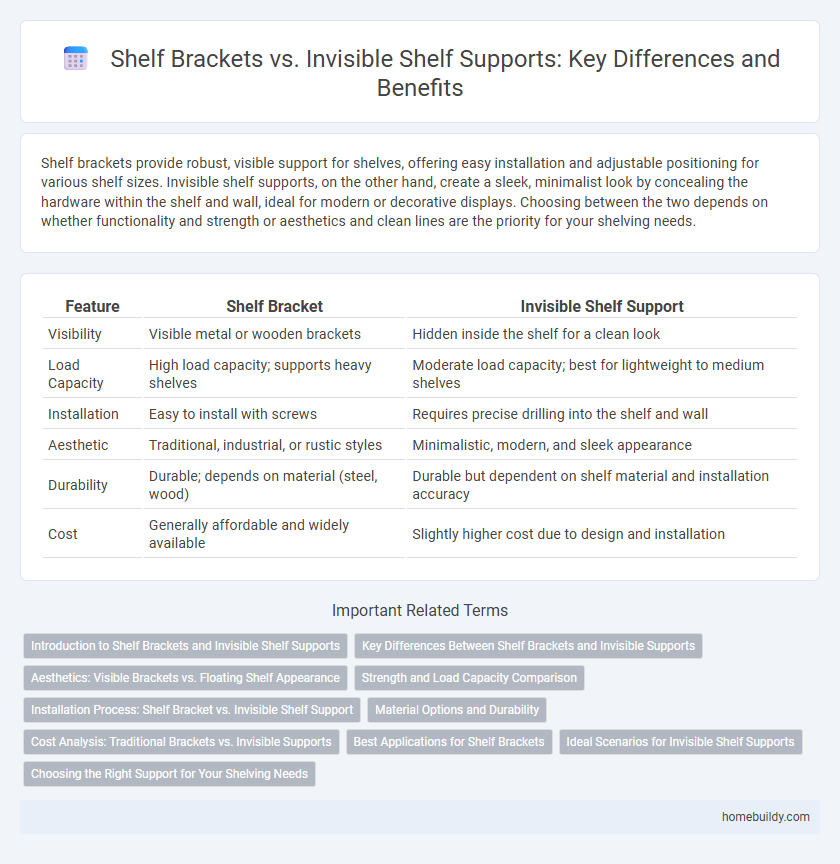Shelf brackets provide robust, visible support for shelves, offering easy installation and adjustable positioning for various shelf sizes. Invisible shelf supports, on the other hand, create a sleek, minimalist look by concealing the hardware within the shelf and wall, ideal for modern or decorative displays. Choosing between the two depends on whether functionality and strength or aesthetics and clean lines are the priority for your shelving needs.
Table of Comparison
| Feature | Shelf Bracket | Invisible Shelf Support |
|---|---|---|
| Visibility | Visible metal or wooden brackets | Hidden inside the shelf for a clean look |
| Load Capacity | High load capacity; supports heavy shelves | Moderate load capacity; best for lightweight to medium shelves |
| Installation | Easy to install with screws | Requires precise drilling into the shelf and wall |
| Aesthetic | Traditional, industrial, or rustic styles | Minimalistic, modern, and sleek appearance |
| Durability | Durable; depends on material (steel, wood) | Durable but dependent on shelf material and installation accuracy |
| Cost | Generally affordable and widely available | Slightly higher cost due to design and installation |
Introduction to Shelf Brackets and Invisible Shelf Supports
Shelf brackets provide sturdy external support for shelving, commonly crafted from metal or wood, and are designed to be visible, adding both functionality and aesthetic appeal. Invisible shelf supports, often made of metal rods inserted into wall and shelf, offer a minimalist look by concealing the support structure within the shelf itself. Choosing between shelf brackets and invisible supports depends on desired visual impact and load-bearing requirements for effective shelf installation.
Key Differences Between Shelf Brackets and Invisible Supports
Shelf brackets are visible support fixtures that attach externally to the wall and shelf, providing robust structural stability and often contributing as a design element. Invisible shelf supports, also known as concealed brackets, are hidden inside the shelf and wall, offering a minimalist appearance while maintaining load-bearing strength through internal mechanisms. Key differences include visibility, ease of installation, weight capacity, and aesthetic impact, with shelf brackets generally easier to install but more visually prominent compared to sleek, modern invisible supports.
Aesthetics: Visible Brackets vs. Floating Shelf Appearance
Shelf brackets offer a sturdy, visually prominent support that adds industrial or rustic charm to any room, showcasing metal or wooden designs as a deliberate style element. Invisible shelf supports create a seamless, floating effect by concealing the hardware within the shelf, enhancing minimalist and modern aesthetics. Choosing between visible brackets and invisible supports depends on desired decor impact, with brackets emphasizing structural detail and invisible supports prioritizing sleek elegance.
Strength and Load Capacity Comparison
Shelf brackets generally provide superior strength and higher load capacity compared to invisible shelf supports, making them ideal for heavier items or larger shelving units. Visible metal or wooden shelf brackets distribute weight more evenly and securely anchor shelves to walls, whereas invisible supports rely on internal pins or rods, which may limit maximum load capacity. For applications requiring robust support, traditional shelf brackets offer a more reliable solution in terms of strength and durability.
Installation Process: Shelf Bracket vs. Invisible Shelf Support
Shelf brackets require drilling holes into the wall and securing the bracket with screws, offering straightforward and visible installation. Invisible shelf supports involve mounting internal rods or pins into the shelf and wall, demanding precise measurements and specialized tools for a clean, hidden look. The installation process for shelf brackets is generally faster and easier compared to the meticulous alignment necessary for invisible shelf supports.
Material Options and Durability
Shelf brackets are typically made from steel, aluminum, or wood, providing strong and reliable support for heavy loads, with coatings like powder coating enhancing their corrosion resistance and durability. Invisible shelf supports, often crafted from stainless steel or metal alloys, offer a sleek, minimalist look while sacrificing some load capacity compared to traditional brackets but excel in resistance to rust and wear. Both options provide durable solutions, but material choice and environmental factors determine longevity and performance in specific applications.
Cost Analysis: Traditional Brackets vs. Invisible Supports
Traditional shelf brackets typically cost between $5 to $20 per unit, offering a budget-friendly option for sturdy support and easy installation. Invisible shelf supports, often made from metal rods or mounts, range from $15 to $50 each, reflecting higher material and manufacture complexity. Despite the higher upfront expense, invisible supports provide a sleek, minimalist aesthetic that can increase perceived value in modern interior designs.
Best Applications for Shelf Brackets
Shelf brackets are ideal for supporting heavy or bulky items such as books, kitchenware, and decorative pieces, providing reliable strength and stability. Their visible design allows for easy installation and adjustment, making them a practical choice for open shelving in garages, workshops, and living spaces. Compared to invisible shelf supports, shelf brackets are better suited for spaces where aesthetics are less critical and durability is a priority.
Ideal Scenarios for Invisible Shelf Supports
Invisible shelf supports are ideal for minimalist interior designs where a clean, floating appearance is desired without visible hardware. These supports are perfect for lightweight to moderate loads, such as displaying decorative items, books, or small plants, maintaining an uncluttered aesthetic. They work best with sturdy, thick shelves made from solid wood or engineered materials that can securely house the support rods.
Choosing the Right Support for Your Shelving Needs
Shelf brackets provide robust, visible support ideal for heavy loads and traditional design aesthetics, while invisible shelf supports offer a sleek, minimalist look by concealing hardware within the wall and shelf. Choosing the right support depends on the weight capacity needed, the desired visual impact, and installation complexity; metal shelf brackets excel in durability and ease of installation, whereas invisible supports suit lighter displays and modern interiors. For optimal shelving performance, assess material strength, shelf depth, and mounting surface compatibility when selecting between shelf brackets and invisible supports.
Shelf bracket vs Invisible shelf support Infographic

 homebuildy.com
homebuildy.com